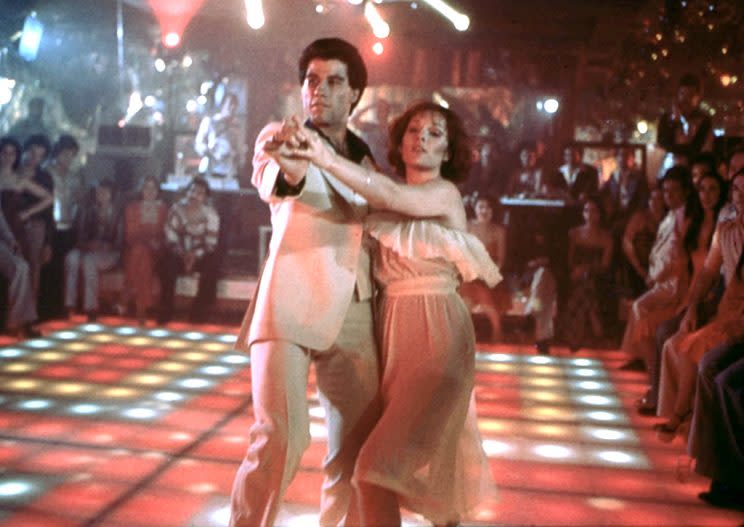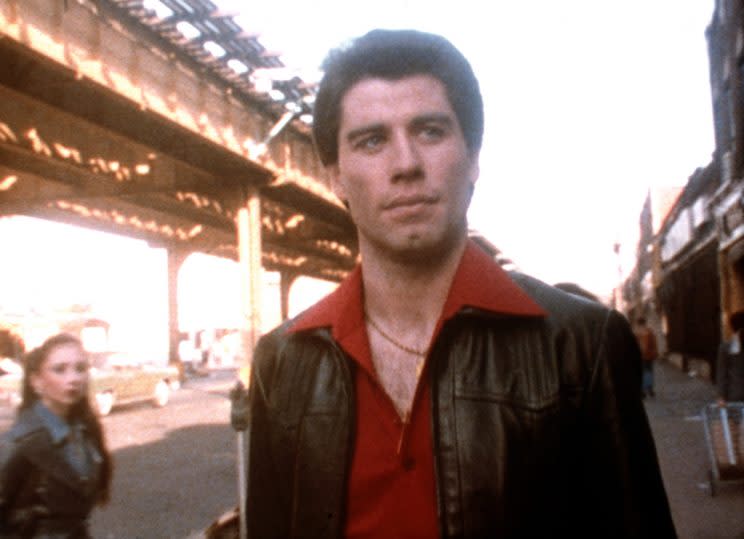'Saturday Night Fever' Director John Badham Talks 40th Anniversary Director's Cut with Restored Scenes

It’s been 40 years, but Saturday Night Fever director John Badham still remembers the moment he knew the low-budget disco movie he filmed in and around the streets of Brooklyn was about to become a big-time success story. The filmmaker — who got his start directing for TV before transitioning to features with 1976’s baseball comedy, The Bingo Long Traveling All-Stars & Motor Kings — had flown into New York for Fever‘s hometown opening. The previous week, Badham had attended a lavish premiere at L.A.’s famed Mann’s Chinese Theater, where the film had received a thunderingly mediocre reception. “It was a very quiet audience,” the 77-year-old director remembers. “Some people gave it no hope of lasting through the first weekend.”
Landing in New York, Badham made a beeline for a theater in Greenwich Village, where the long line for a 10 p.m. showing told a very different story. “My driver said, ‘I’ll have to drive around the block,’ and as we went, the line kept going and going and going. I walked into the lobby, and all the Paramount executives were jumping up and down. They were so excited. I just thought, Wow, this is something.”
Powered by John Travolta‘s career-defining performance as ambitious dancer Tony Manero, not to mention a chart-topping soundtrack with five classic Bee Gees tunes, Saturday Night Fever‘s status as a pop culture touchstone has endured for four decades. On May 2, the film will celebrate its 40th birthday in style with the Blu-ray debut of an all-new director’s cut supervised by Badham, followed by a Fathom Events-hosted theatrical premiere on May 7 and 10 in 700 theaters. Yahoo Movies spoke with Badham about Fever‘s legacy, the new scenes featured in the director’s cut, and the movie’s controversial rape sequence.
John Travolta is the center of attention on the dance floor in ‘Saturday Night Fever’:
People sometimes forget there’s more to Saturday Night Fever than disco — there’s a real emotional darkness at its core.
That’s absolutely true. People walk away with a memory of the music, and the great dancing, but the core of it is very dark. That’s the first thing that I noticed when I read the script. It appealed to me on that level first, and only then did I go, “Oh my God! This is a musical.”
The movie is a gritty, vibrant portrait of a vanished Brooklyn. In that way, it feels influenced by Sidney Lumet, who was a contemporary of yours.
To some people’s thinking, it’s not good to make a picture that lands you so specifically in an era, but we just made the choice that we were gonna buy clothes that were right off the rack, and treat it almost like a documentary of Brooklyn at the time. And certainly, Sidney Lumet is somebody that I admired. I also have to give a lot of thanks to Martin Scorsese. Mean Streets had a big influence on me. That’s one of the first films that I started thinking about as I was working on Saturday Night Fever.
How does the director’s cut differ from the theatrical release?
We were able to restore several scenes that had been eliminated from the original version. As will always happen right before a film is released, everybody gets really nervous, and we cut three or four relatively small scenes. We wanted to get the movie going and didn’t want it to run over two hours. So a few things went by the wayside that told us more about these characters. We have one new scene toward the end where Tony’s dad gets his job back, and he and his mom are really excited, jumping around in the kitchen and carrying on. Meanwhile, Travolta is just kind of standing in the corner sneering at this whole thing. It’s kind of wonderful because here is this happy moment in their lives, and he’s just really kind of cynical about the whole thing. That was part of the genius of Norman Wexler‘s script; he was able to show that our lives aren’t all happiness and light, and it also isn’t all dark. There are many ways life goes.
Is there a new Tony-specific scene that you’re particularly eager for people to see?
Early on in the film, after the first disco sequence, there’s a scene where he goes riding with his friends in the daytime, and he’s listening to them arguing about how you’ll never get anywhere in this life, and you’re just kind of stuck at the level that you’re at. He gets disgusted with them, and that’s all you hear in the original version of the movie. But in the scene that we put back in, he makes them stop the car; he gets out, they drive off without him, and he’s left standing overlooking the Verrazano Bridge. You can tell there’s a real connection just from the way he’s looking at it, and his fingers start drawing the lines of the extension bridge in the air. It’s a sweet moment that gives you a softer side of him after we’ve seen some of the tougher sides.
John Travolta owns the dance floor in ‘Saturday Night Fever’ solo turn:
Have you spoken with John Travolta recently about the movie’s legacy? He must have a complicated relationship with it as it defined his image for so long.
John sent me a Christmas card last year, and I wrote him back and told him how much I liked his work in the O.J. miniseries [The People v. O.J. Simpson]. I told him we were about to come out with this new director’s cut, and he wrote me back and said that he was really delighted to hear about it, and couldn’t wait to see it.
Certainly, one of the most shocking moments in the film is Annette’s [played by Donna Pescow] rape scene. Was that a difficult scene to shoot at the time? How do you feel when people watch it now?
I was kind of reluctant to shoot very much of that scene at all, and kept trying to look for ways to more hint at it. But [producer] Robert Stigwood was very insistent that we do it relatively strongly. So what you see is me trying to hint at it without showing too much, and by playing it a lot off of Annette’s grief and Travolta’s disgust at the whole thing. He doesn’t participate in it, and he’s looking down on those guys who are participating in it, and he’s looking down on her, too. It’s still unpleasant, there’s no getting around that, but it’s important that he sees it all. It’s one other thing that eventually drives him to leave Brooklyn — that and the death of his friend, Bobby, who falls off the Verrazano bridge.
Forty years later, it’s hard for modern New Yorkers to recognize how thoroughly disco culture dominated the city. What are your memories of those clubs and how did they impact the way you made the film?
I did my homework, and went to many, many discos in and around the New York area. And there was every conceivable kind of disco for one group or another at the time; there were upscale yuppie discos, various kinds of gay discos — whatever you wanted. I spent time in all of those places, and went back to the one that we used in the film [2001 Odyssey, located in Bay Ridge, Brooklyn, until it closed in 2005] because it reflected our characters. We liked the look of the inside of that disco, and added the whole dance floor. [That floor was later the subject of a prolonged legal battle.]
John Travolta in the classic white suit with Karen Lynn Gorney in ‘Saturday Night Fever’:
The walls of the club were very plain, so my production designer, Charles Bailey, came in with rolls and rolls of aluminum foil, and hung it like wallpaper from the ceiling, along with little white Christmas lights stuck in there. So if you look in the background of the disco scenes, you can actually see something that looks like slightly crinkled up aluminum foil and little lights. But it brought some life to the place; when shooting was over and we’d turn the regular lights on, all the magic just goes away. But it was a nice transformation. I know the owner was just thrilled. We took him to dinner one night, and he said, “You boys make my place look so good!” I know the last time I went there, months and months after the film was released, it looked the same.
Did you ever watch the sequel, Staying Alive, which Sylvester Stallone directed six years later?
I did see it. It was not a script that appealed to me, so I politely backed off [directing it]. I thought it was an interesting choice that they made to have Stallone do it; that was something that would bring a fresh eye to it. And Tony was in a fresh world anyway, so I was very positive about it.

It’s hard to imagine the film opening any other way than with Travolta strutting down the street to the tune of “Staying Alive.” But was there ever an alternate version of the first scene, with different imagery or music?
It was scripted that Tony would be walking down the street, carrying this paint can and dressed like he was going to the disco. The Bee Gees gave me their demo songs and when I listened to their five demos, I just knew that “Staying Alive” had to go with that to open the film. I also knew that the first thing we should see were his feet in those very special purple shoes. You can tell that his mind is not on his work; it’s on dancing, looking cool, and being a stud out on the street. It puts the focus right away on who the main character is and what’s on his mind. It just happened to come together beautifully like that.
John Badham’s ‘The Bingo Long Traveling All-Stars & Motor Kings’: Watch a trailer:
Read More from Yahoo Movies:


